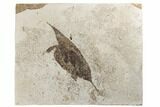This Specimen has been sold.
7" Eocene Fossil Leaf (Allophylus) - Green River Formation
This is a 7" long fossil leaf from the plant Allophylus flexifolia. Allophyllus is a genus of flowering plants in the Sapindaceae (Soapberry) family, members of which still survive today.
It is Eocene in age and comes from the famed 18 Inch Layer of the Green River Formation. It's in great shape with fine detail and a dark coloration which contrasts well against the shale. It appears to have preserved over the top of a fossil fish whose spine can be seen running through the leaf.
This specimen includes a metal/acrylic stand.
It is Eocene in age and comes from the famed 18 Inch Layer of the Green River Formation. It's in great shape with fine detail and a dark coloration which contrasts well against the shale. It appears to have preserved over the top of a fossil fish whose spine can be seen running through the leaf.
This specimen includes a metal/acrylic stand.
About The 18 Inch Layer Of Fossil Lake
Specimens like this come from the coveted 18 inch layer of the Green River Formation, which produces darker and more detailed fish than the majority on the market. The rock from this layer is much harder and more durable than other layers in the formation, likely due to its initial deposition conditions in deep water. Because of these conditions, fish found in the 18-inch layer can be extracted whole and in excellent condition. This layer is typically collected at night using low-angle light to see the bump in the rock that the fish's backbone creates. They then cut these fish out and take them to a lab where the fish, which may be up to an inch under the surface of the rock, are meticulously extracted under microscope with hand tools.
Specimens like this come from the coveted 18 inch layer of the Green River Formation, which produces darker and more detailed fish than the majority on the market. The rock from this layer is much harder and more durable than other layers in the formation, likely due to its initial deposition conditions in deep water. Because of these conditions, fish found in the 18-inch layer can be extracted whole and in excellent condition. This layer is typically collected at night using low-angle light to see the bump in the rock that the fish's backbone creates. They then cut these fish out and take them to a lab where the fish, which may be up to an inch under the surface of the rock, are meticulously extracted under microscope with hand tools.
SPECIES
Allophylus flexifolia
LOCATION
Lindgren Quarry, Kemmerer, Wyoming
FORMATION
Green River Formation, 18 Inch Layer
SIZE
7" long on 10.1 x 8" rock
CATEGORY
SUB CATEGORY
ITEM
#189310
We guarantee the authenticity of all of our specimens.
 Reviews
Reviews












